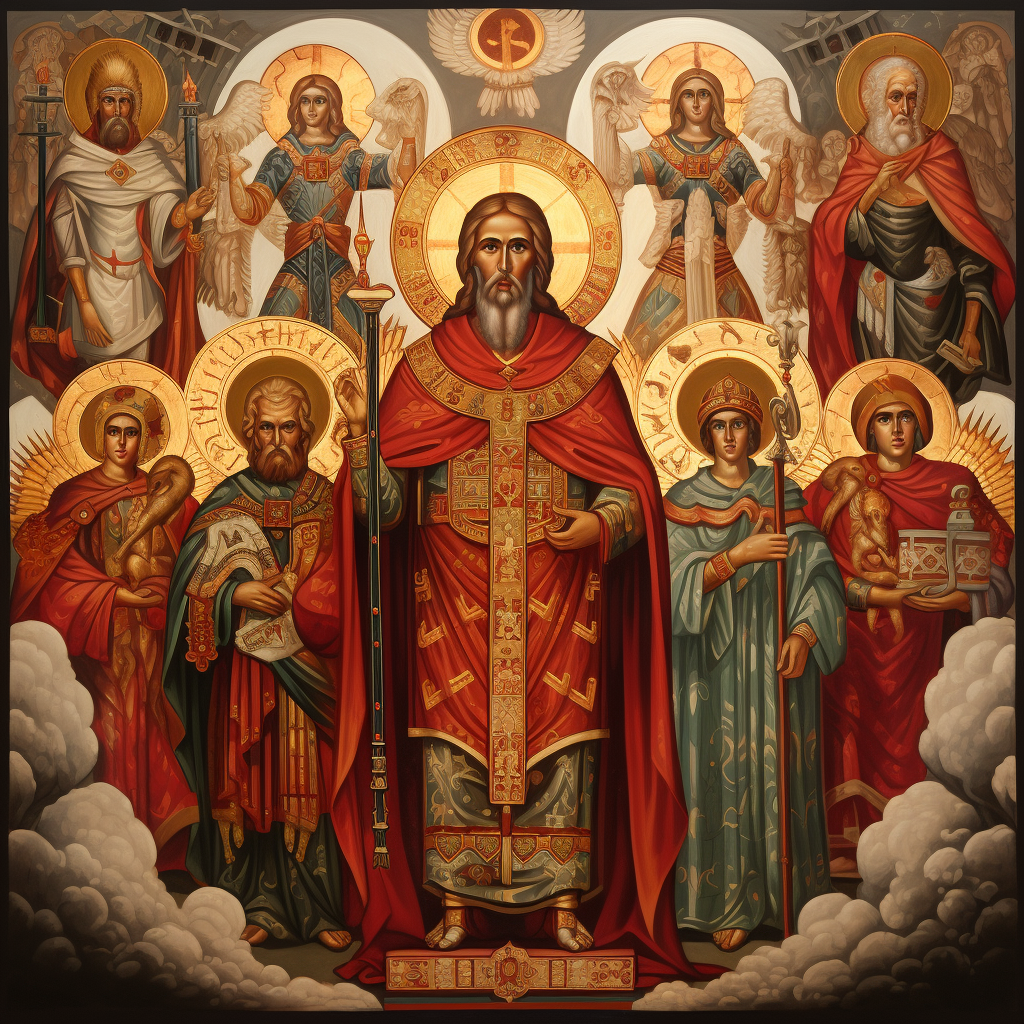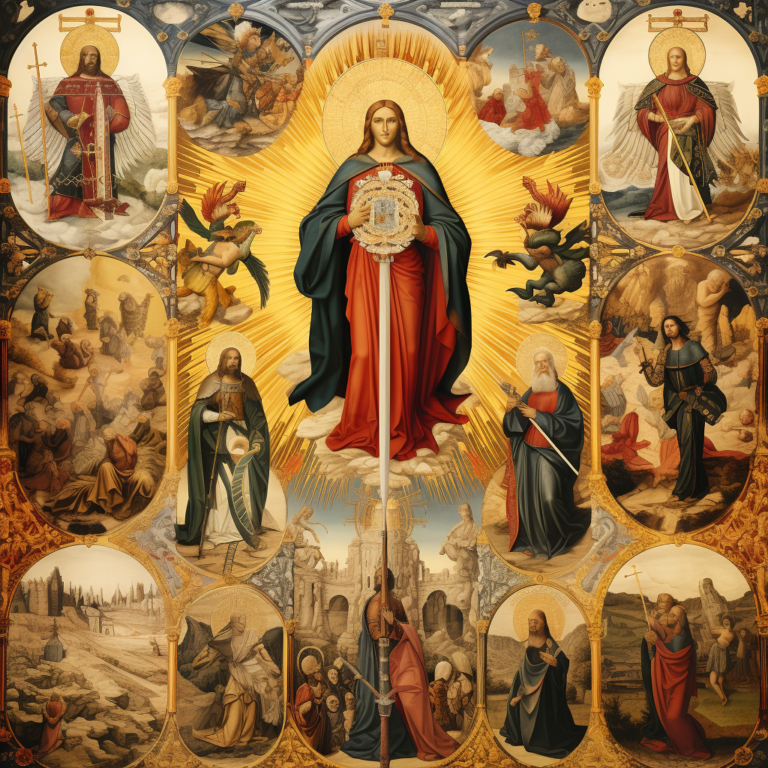Christianity, over centuries, has been richly adorned with a plethora of saints, each exuding a distinct personality, path, and purpose. Often, these saints are associated with unique symbols that serve to represent their essence and their immense contributions to the faith.
Understanding the Symbolism
Delving into the world of hagiographies, we encounter countless symbols meticulously paired with saints, each a spiritual rivulet enriching the greater river of Christianity. The practice of linking symbols with saints, also known as iconography, has had a long-standing history tracing back to the cradle days of Christianity.

During the early centuries, the ability to read and write was a luxury to many. Thus, the pictorial representation of saints with specific symbols emerged as an influential mode of communication. Serving as a visual gospel, these symbols transcended the barriers of age, language, and literacy. They brought to life the virtues and spiritual feats of the saints, stimulating the interest and making the majestic divine narratives accessible to the ordinary Christian masses. For instance, Saint Lawrence, a 3rd-century martyr, is often depicted with a grill, illustrating the manner of his martyrdom and thereby instantaneously etching his sacrifice in the devotee’s memory. These symbols extend beyond mere pictorial representation. They effectively condense the saint’s life, virtues, and spiritual paths into a simple yet profound visual metaphor. For example, the “keys” in Saint Peter’s iconography are symbolic of his role as the “Keeper of the keys to the Kingdom of Heaven,” emphasizing his authority and leadership in the nascent Church.
Symbols play a profoundly transformative role, shaping believers’ understanding and perception of saints. Instead of being regarded as remote historical figures, saints, via their symbols, metamorphosize into intimate companions for the spiritually inclined. These insignia invite earnest believers onto a richer plane of contemplation and connection, enabling them to navigate their own spiritual journeys more fruitfully.
Icons are more than paint on wood. They serve as tangible links, binding the past to the present, the divine to the human, and the saint to the devotee. By their powerful visual appeal, they call the beholder to delve deeper into an understanding of their faith and the virtues that the saints embody.
Common Symbols and Their Associated Saints
As one ventures deeper into the realm of Christian symbolism, an enchanting world of symbolic links unfurls, each offering a glimpse into the enigmatic lives and virtues of Christian saints. A comprehensive understanding of these symbols provides us with an incredible way of exploring not only the facets of each saint but also the depth of Christian values and histories they represent.
Beginning with one of the most recognized apostles, St. Peter, he is often symbolized by a set of keys. This symbolism dates back to the biblical episode where Jesus Christ explicitly designates St. Peter as the metaphorical keeper of the ‘keys of the kingdom of Heaven’, thereby illustrating his spiritual authority and foundational role in the establishment of the Church. The key remains a time-honored emblem of guidance and shelter and a nod to St. Peter’s role in leading the flock to salvation.
We encountered St. Patrick, the patron saint of Ireland. His symbolic whisper is a three-leaved shamrock, a ubiquitous plant in Irish landscapes. St. Patrick ingeniously used the shamrock to elucidate the complex concept of the Holy Trinity, signifying that the Father, the Son, and the Holy Spirit, though three distinct entities, are united in essence. This simple blossom has, since then, become hallowed, reminding the faithful of the divine unity underlying Christian belief.
Finally, we step onto the path tread by St. Lucy, the patroness of the blind. Known for her compassionate soul and impenetrable faith, St. Lucy is symbolized by holding a plate carrying eyes. Rooted in the story of St. Lucy offering her eyes to a suitor who admired them, only to have them miraculously restored later, this symbol serves as a stark reminder of her sacrifice, courage, and miraculous healing prowess.
These emblems perform a silent sermon, evoking respect towards the saints and inspiring followers to demonstrate a similar courage, faith, and selflessness in their spiritual journeys.
In the realm of Christian art and iconography, these symbols hold an extraordinarily prominent place. Artists, for generations, have employed these symbols to add layers of meaning to their works. Byzantine and Renaissance art in particular teem with saints complete with respective symbolism. This clever use of symbols often aided the faithful in identifying and understanding the saint’s portrayal and their stories, even if they couldn’t read the accompanying text. Thus, these symbols reflect not merely the religious significance, but also the historical and cultural essence of their epochs.
Modern-day Usage and Perception of Symbolism of Saints

The impressions left by saints and their corresponding symbols continue to mold the evolution of modern Christianity, standing as testaments of unbroken continuity of faith. Into the modern era, these symbols have evolved from their direct, visual-use origins, honing more metaphorical connotations. Their spiritual significance remains firmly anchored in the hearts of the devout.
Even as the world has steeped deeper into literacy and technology, the symbolism of saints retains its impact and relevance. The symbols no longer serve solely as a narrative strategy but have metamorphosed into profound spiritual aids. They now play a vital role in church architecture, from carvings on altars to figures illuminating stained glass windows. Religious vestments feature them as reminders of specific saints and their virtues. Personal religious paraphernalia such as medallions and rosaries also incorporate them, turning each accessory into a personal spiritual companion guiding the believer towards contemplation and connection.
The perception has slowly shifted from outward recognition to inward reflection. The symbols today stimulate personal introspection, inspiring individuals to emulate the saint’s virtues in their own lives. St. Peter’s keys remind one of the spiritual authority they hold within themselves, St. Patrick’s shamrock refers to the unity of the divine elements, and St. Lucy’s portrayal encourages the courage of faith, illustrating how these symbols serve as modern reminders of eternal virtues.
Interestingly, the amalgamation of saints’ symbolism into modern Christian practice has painted a captivating tapestry intertwining faith, culture, and art. These symbols encapsulate not only the tales of valor, sacrifice, and steadfast faith of the saints, but they also breathe a renewed sense of relevance and resonance into today’s spiritual landscape. Constant navigators on our spiritual sojourn, these symbols continue to illuminate our paths and deepen our understanding of our faith.
An exploration into saints’ symbolism is not merely an intriguing journey into the roots of Christian history; it is also a mirror reflecting our own spiritual pursuits and aspirations. It marks a compelling testament to Christianity’s dynamic adaptation while subtly underlining the enduring essence of the faith.